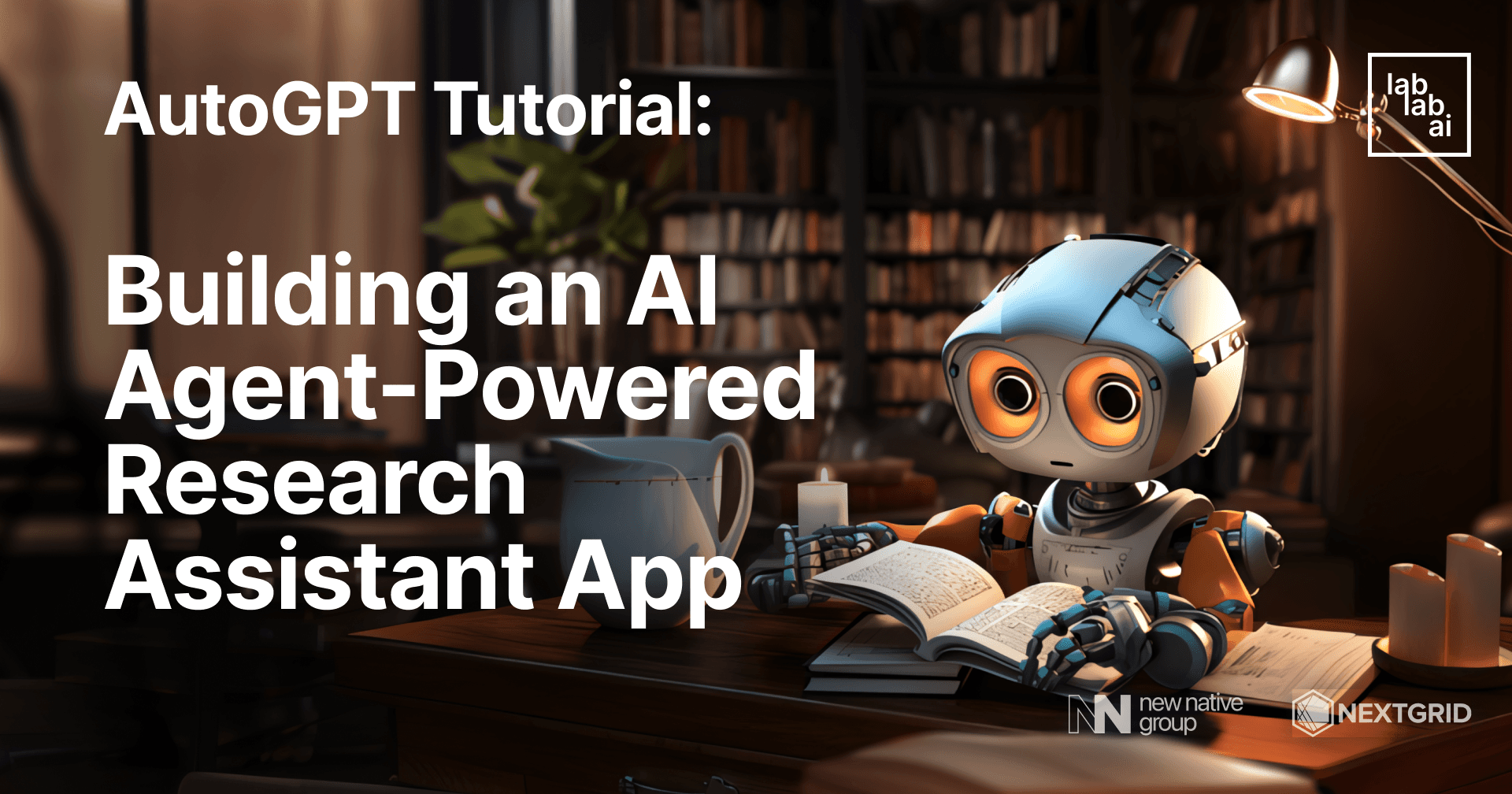The Power of AutoGPT: Exploring Intelligent Agents and Their Types, Functions & Composition
Imagine a world where your daily tasks are made simpler, with the help of an intelligent AI assistant that not only understands your needs but also learns and improves with each interaction. Sounds too good to be true? Well, prepare to be amazed, as that world is closer than you think thanks to AutoGPT and the advancements in autonomous AI agents. In this blog post, we will delve into the fascinating world of artificial intelligence and explore the capabilities of AutoGPT, its inner workings, and the real-world applications that can revolutionize various industries.
Get ready to embark on a journey through the world of AutoGPT, where we’ll explore the different agent types, key features, and how this powerful AI assistant can be harnessed to simplify tasks for developers and end-users alike. Along the way, we’ll also address the ethical considerations surrounding AI and discuss the emerging trends and technologies that will shape the future of autonomous AI assistants.
Key Takeaways
- AutoGPT is an autonomous AI assistant based on the GPT-4 language model, offering a variety of applications from content creation to medical diagnosis.
- The iterative process and expanding capabilities open up new opportunities for businesses and individuals.
- Adopting ethical considerations and staying informed of emerging trends are essential for successful implementation in the future.
Understanding AutoGPT: The Autonomous AI Assistant
AutoGPT is an AI assistant that offers:
- Simplified tasks for developers and end-users
- An intuitive interface
- Objective performance assessment
- Content creation and marketing assistance
- Data fetching through online research
- Developer tools and automation capabilities
Harnessing the power of artificial intelligence, AutoGPT is a rational agent that makes decisions based on its agent function, which utilizes knowledge and understanding of the environment, complementing the role of a human agent. As one of the intelligent agents, AutoGPT demonstrates the potential of AI in decision-making processes, including the use of model based reflex agents and simple reflex agents operating in collaboration with other rational agents, such as a robotic agent.
Examining the inner workings of AutoGPT reveals:
- An autonomous AI assistant that utilizes the agent protocol from the AI Engineer Foundation
- Various sensors for data collection
- Problem-solving algorithms
With its software agent design, AutoGPT is equipped to carry out tasks autonomously through its agent program, edging us towards a future where AI agents have an ever-increasing role in everyday life.
What is AutoGPT?
AutoGPT is a remarkable leap forward in the realm of autonomous AI agents, as it is built upon the powerful GPT-4 language model and is capable of performing goal-oriented actions through language input. This innovative AI assistant takes decision-making to a whole new level, going beyond simple reflex agents, and incorporating advanced capabilities that make it an invaluable tool in various applications.
As an AI agent, AutoGPT can be classified alongside goal based agents and utility based agents, which means it selects actions based on the expected utility of the outcomes. This unique characteristic allows AutoGPT to adapt to various situations and tasks, making it a versatile and effective solution for those seeking the assistance of an intelligent agent, such as a utility based agent.
Key Features of AutoGPT
With an impressive array of features, AutoGPT has quickly established itself as a force to be reckoned with in the world of AI agents. Its key features include the iterative process, ever-increasing capabilities, and a modular framework that allows for customization and expansion. These features set AutoGPT apart from other AI agents, making it a valuable asset for users seeking an intelligent and adaptable solution to their needs.
The open-ended nature of AutoGPT makes it an exciting prospect for developers who wish to build upon its existing framework, opening up a world of possibilities for future advancements. Additionally, AutoGPT’s autonomous, goal-oriented, and multi-purpose capabilities allow it to perform multiple tasks simultaneously, further enhancing its appeal to users across various industries and applications.
How AutoGPT Works: From GPT-4 to Autonomous Actions
At its core, AutoGPT relies on the GPT-4 language model, memory, and internet access to accomplish tasks, following an iterative process that continues to improve with each experience. This unique approach allows AutoGPT to learn from its previous attempts and adapt its responses accordingly, resulting in a more efficient and effective AI agent.
The foundation of AutoGPT’s autonomous behavior is impressive, as it allows the AI agent to function with minimal human input while still delivering exceptional results. By combining the power of GPT-4 with its own intelligent algorithms and expansive knowledge base, AutoGPT is set to revolutionize the way we interact with AI agents and accomplish our daily tasks.
The Iterative Process
The iterative process that powers AutoGPT is made up of five key steps:
- Goal initialization
- Task generation
- Information search
- Feedback assessment
- Continuous improvement
By following this cyclical process, AutoGPT actively learns from its experiences, refining its actions and delivering increasingly better results over time.
This process not only sets AutoGPT apart from other AI agents, but also showcases the potential for future developments in the realm of artificial intelligence. As more advanced algorithms and technologies are incorporated into AI agents like AutoGPT, we can expect to see even more impressive results and capabilities in the near future.
Expanding Capabilities
One of the most exciting aspects of AutoGPT is its potential for expansion, as developers can build on top of its existing framework to introduce new features and capabilities. This opens up a world of possibilities for the future of AI agents, as we can expect to see even more advanced and versatile solutions emerging in the years to come.
As AutoGPT continues to grow and evolve, the applications for this powerful AI assistant will become even more diverse, opening up new opportunities for businesses and individuals alike. From content creation to online research and developer tools, the future of AutoGPT and autonomous AI agents is truly promising.
Getting Started with AutoGPT: Installation and Setup
Ready to harness the power of AutoGPT for yourself? Getting started is easier than you might think. By accessing and downloading AutoGPT from its GitHub repository, you can install the necessary files and dependencies to bring this intelligent AI assistant to life on your own system.
Once you’ve downloaded AutoGPT, the next step is to follow the detailed installation instructions and tutorials provided on the official website. These guides will ensure you configure dependencies, environment variables, and integrate with the OpenAI API correctly, allowing you to unlock the full potential of AutoGPT.
Accessing AutoGPT from GitHub
To access AutoGPT from GitHub, simply follow these steps:
- Visit the official repository.
- Download the required files and dependencies.
- Install AutoGPT on your system.
- Begin exploring its impressive capabilities.
After downloading the files, adhering to the installation instructions provided on the GitHub repository and the official website is key. This way, you’ll correctly set up your environment and secure the necessary API keys to fully utilize AutoGPT’s extensive features.
Installation and Configuration
Adhering to the step-by-step installation and configuration guide on the official AutoGPT website guarantees a smooth and successful setup process. These instructions will enable you to establish the necessary API keys and environment variables, setting the stage for AutoGPT to operate at its best.
Once you’ve completed the installation and configuration process, you’ll be ready to explore the wide range of applications and benefits that AutoGPT has to offer. From content creation to online research and developer tools, the possibilities are truly endless.
Real-World Applications of AutoGPT
AutoGPT’s real-world applications are vast and varied, making it an invaluable tool for users across a range of industries and sectors. Its impressive capabilities include:
- Content creation
- Marketing
- Online research
- Data retrieval
- Developer tools
These features make AutoGPT a highly versatile solution for businesses and individuals alike.
As AI technology continues to advance, we can expect to see even more impressive real-world applications for AutoGPT and other autonomous AI agents. Some potential applications include:
- Automating mundane tasks
- Providing intelligent insights
- Assisting in medical diagnoses
- Enhancing customer service experiences
- Optimizing supply chain management
- Personalizing user experiences
- Improving cybersecurity measures
The potential for AI agents to revolutionize the way we live and work is truly exciting, especially when considering the advancements in agent based modeling, the emergence of model based agents, and the growing role of reactive agents.
Content Creation and Marketing
In the realm of content creation and marketing, AutoGPT offers an array of benefits, capable of streamlining tasks and optimizing efficiency. From generating ideas and headlines to improving writing quality, AutoGPT can help users produce engaging and high-quality content with ease.
Beyond content generation, AutoGPT also offers automation capabilities for marketing activities. This includes automating email campaigns, segmenting customers, and even enhancing customer service, making it an indispensable tool for businesses looking to optimize their marketing efforts.
Online Research and Data Retrieval
AutoGPT’s capabilities extend to online research and data retrieval, making it an invaluable tool for users in need of accurate and up-to-date information. By crawling the web and providing results via email, AutoGPT simplifies the research process and saves users valuable time and effort.
Whether you’re looking for specific data points or conducting in-depth research on a particular topic, AutoGPT’s powerful algorithms and expansive knowledge base make it an ideal solution for all your online research needs.
Developer Tools and Automation
For developers, AutoGPT offers a range of tools and automation capabilities designed to streamline tasks and enhance efficiency. By automating development activities such as code generation and debugging, AutoGPT can help developers focus on more strategic and creative tasks.
In addition to its developer tools, AutoGPT also offers automated workflows and processes, allowing users to optimize complex tasks and increase productivity. By identifying potential errors and recommending improvements, AutoGPT can even help improve the overall quality of your code.
The Future of AutoGPT and Autonomous AI Assistants
As the world of AI continues to evolve, the future of AutoGPT and autonomous AI assistants is truly promising. With advancements in technology and the increasing adoption of AI agents across various industries, it is clear that AI assistants like AutoGPT will play an even greater role in our lives moving forward.
As we navigate towards this AI-centric future, addressing ethical considerations and emerging trends that will influence the development and acceptance of AI agents like AutoGPT becomes imperative. This proactive approach ensures that our use of AI remains responsible, sustainable, and beneficial to all.
Ethical Considerations
With the growing prevalence of AI agents in our lives, tackling the ethical considerations that emerge from their widespread use becomes vital. We need to thoughtfully consider and address issues like AI bias, responsibility for AI errors, and the potential job impact to maintain a responsible approach to AI development and acceptance.
By acknowledging and addressing these ethical concerns, we can develop AI agents like AutoGPT in a way that minimizes potential harm and maximizes the benefits they bring to our lives. This will ensure a more sustainable and responsible future for AI technology and its applications.
Emerging Trends and Technologies
As new trends and technologies emerge in the AI landscape, they will undoubtedly shape the future development and adoption of autonomous AI assistants like AutoGPT. Advancements in AI algorithms, machine learning, and natural language processing will continue to push the boundaries of what AI agents can achieve, leading to even more impressive capabilities and applications.
By staying informed of these emerging trends and technologies, we can better understand the potential impact on AutoGPT and other AI agents, ensuring that we are prepared for the exciting future ahead in the realm of artificial intelligence.
Summary
Throughout this blog post, we’ve explored the fascinating world of AutoGPT and autonomous AI agents, diving into their capabilities, inner workings, and real-world applications. From content creation and marketing to online research and developer tools, AutoGPT offers a wide range of benefits that have the potential to revolutionize the way we work and live.
As we look to the future, it is essential to consider the ethical implications of AI and stay informed of emerging trends and technologies that will shape the development of AI agents like AutoGPT. By doing so, we can ensure a responsible and sustainable approach to AI that benefits us all.
Frequently Asked Questions
What is AutoGPT used for?
AutoGPT is an open source autonomous AI agent based on the GPT-4 language model. It can autonomously chain together tasks to achieve a goal set by the user and is used to streamline and automate day-to-day tasks such as email responses, customer support responses, or social media content.
This makes AutoGPT a powerful tool for businesses and individuals alike, allowing them to save time and money while still providing quality customer service. It can also be used to create content quickly.
How to install AutoGPT?
To install AutoGPT, first install Python 3.x or Git, then clone the AutoGPT repository (Git), install the required packages, configure settings, create environment variables, add API keys, and finally run the starting command.
Is AutoGPT free?
Yes, AutoGPT is free to use. It is an open-source application that can be downloaded for no charge, allowing you to take advantage of its powerful capabilities at no cost.
What is an example of AutoGPT?
AutoGPT is a versatile technology that can be used for automating social media posts, creating complex websites, and even writing tweets based on the analysis of a user’s Twitter profile.
What is an AutoGPT agent?
AutoGPT is an open source autonomous AI agent based on the GPT-4 language model which uses statistical and probabilistic techniques to determine the probability of a given sequence of words.
It autonomously chains together tasks in order to achieve user-defined goals, streamlining the process typically used to operate chatbot systems such as ChatGPT.




